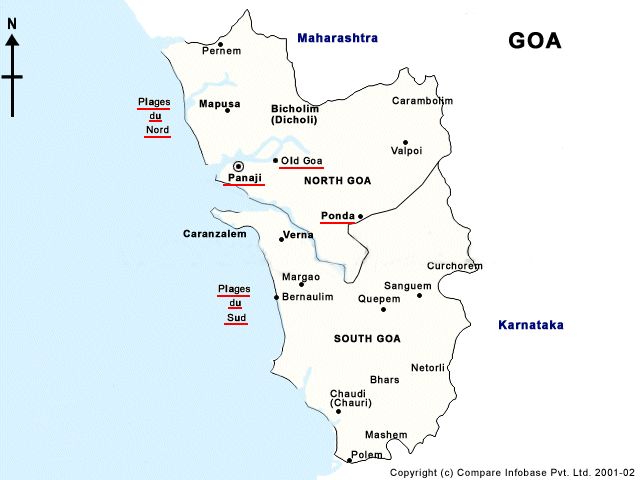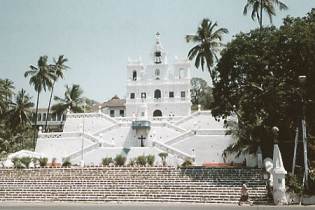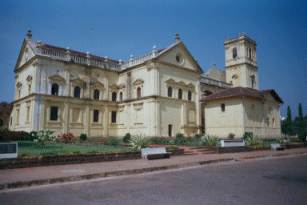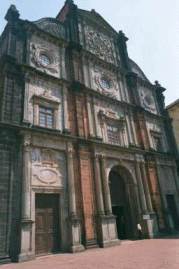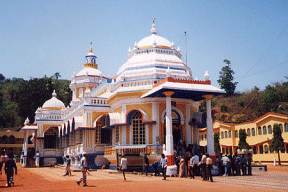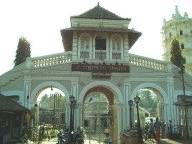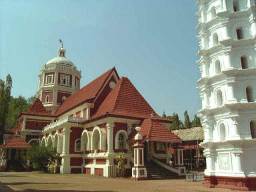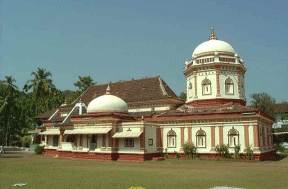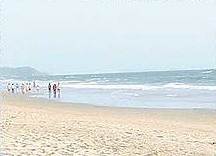Goa is the smallest state of the Indian Republic and yet one of the best known. Covering an area of 3700 km2, it welcomes 1.3 million inhabitants, the Goanais. The capital is Panaji and the official language is the konkani. Former Portuguese colony, Goa has since become part of India in 1961 a tropical paradise for Westerners in search of a change of scenery. Like Pondicherry, the cities of Goa have kept this retro architecture of European metropolises. The presence of Catholics is still very strong. Goa not only offers landscapes of postcards but also many sites to visit.
Today Goa lives mainly in fisheries and tourism, whose anarchic development tends to distort natural sites.
History
The first references of Goa are found in the Mahabharata under the name of Gomantak. It speaks already of its paradisiacal and fertile aspect. Known to Greek and Arab travelers, the region of Goa was under the tutelage of many kingdoms, including that of Ashoka in the 3rd century BC Many dynasties disputed the control of Goa which was never a capital. In 1510, when the Portuguese landed in Goa, the region was governed by Muslims.
The Portuguese who had already built a few forts in Kerala needed a port to control the spice trade. They come in force and let the Catholic Inquisition rage against non-Christians. In the middle of the seventeenth century the influence of the Portuguese declined against the British but they managed to keep Goa.
At the beginning of the 20th century colonialism was violently criticized. In 1947 India obtained its independence but will have to wait until 1961 before recovering Goa by the force.
Map of the province of Goa
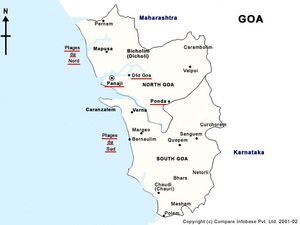
Map of the province of Goa
Panaji
The capital of the state of Goa is a charming little town with a Latin style. In the time of the Portuguese the city was called Panjim.
In 1759 the Viceroy Dom Manuel of Saldanha de Albuquerque moved and moved to Panjim at Fort Adil Shah. The city developed only under the government of DOM Manuel de Castro of Portugal (1826-1835). He built the city, built many buildings and a drainage system. On 22 March 1843 a royal decree made it the capital of the region. Today, the city is traditionally divided into two districts: Fontainhas and Sao Thome
Our Lady of the Immaculate Conception
Built in 1541 and rebuilt in 1619 it would be one of the oldest churches in India. The Portuguese sailors used to come and gather here on their arrival in Goa. It is known for its curious staircases in zigzag added in the nineteenth century and for its big clock. A chapel dedicated to Saint Francis Xavier is inside and two baroque altars.
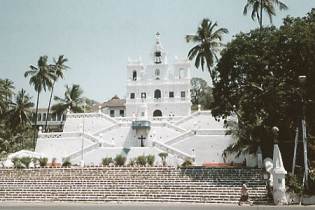
Our Lady of the Immaculate Conception
The Secretary
Probably the oldest building in Panaji. This building was originally the palace of Sultan Adil Shah, then it became the residence of the Portuguese Viceroy in 1759 until 1918. At independence the authorities installed the Goa Secretariat, the Legislative Assembly and the offices government.
The temple of Mahalaxmi
This temple was built in 1818 with the authorization of the Portuguese after 300 years of prohibition. The temple deity, in black stone, comes from the village of Taleigao and was hidden in Bicholim in the 16th century to escape destruction.
The old quarters
The old quarters of Fontainhas and Sao Thome are the oldest and most picturesque of Goa. The small cobbled streets lined with small houses with balconies and painted shutters recall the villages of Portugal. The small chapel of Saint Sebastian does not look good but contains beautiful objects including a crucifix on which Christ has open eyes.
Old Goa
Old Goa was, under the name of Ela, the capital of the region during the reign of Adil Shah. It almost became the capital of the kingdom of Bijapur, but the arrival of the Portuguese decided otherwise. The latter made of it a magnificent city that was nicknamed "the Lisbon of the Orient". In 1759, the seat of the Vice-Kingship was moved to Panaji. After losing its status as capital in 1843 Old Goa declined rapidly. Today, Old Goa is a pilgrimage town for Catholics.
The Cathedral of Se
The Portuguese built a first church there in 1510 and a second in place in 1515. It became a cathedral in 1538 with the creation of the diocese of Goa. The building as it appears today was erected between 1562 and 1652 by decision of the Viceroy.
Its exterior architecture combines the Tuscan style and the Doric style, while the interior architecture is inspired by the Corinthian style. Originally the building consisted of two towers but the north one collapsed in 1776. The south tower houses a very large bell called "the golden bell". The interior contains very beautiful chapels richly decorated.
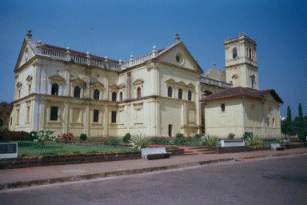
The Cathedral of Se
The Church of Saint Francis of Assisi
The convent and the church of San Francis of Assisi were created by the Franciscans who landed in Goa in 1517. At that time there was only a chapel consecrated in church in 1521. In 1835 the convent was closed by Portuguese and expelled monks. Since 1964, it houses the archaeological museum.
The church was rebuilt in 1661 in the Tuscan style for the exterior and in the Corinthian style for the interior. You can admire paintings and Biblical frescoes. Of the original six chapels, only three remain. A wooden statue of St. Francis of Assisi is in one of them.
The Basilica of Bom Jesus
The most famous of the religious buildings of Goa since it houses the relics of St. Francis Xavier, patron of Goa. This Jesuit was sent to the East in 1541 to evangelize the Portuguese colonies. He died in China and his followers saw the incorruptibility of his body and brought him back to India. The miracle was recognized by the Church and François-Xavier was canonized in 1662. The relics of the body are contained in a crystal urn since 1955, itself enclosed in a glass coffin. They are the subject of a public exhibition every ten years. The chapel that houses it is a masterpiece of Italian art. It has beautiful paintings about the life of the saint.
The construction of the basilica began in 1594 and was consecrated on May 15, 1605. The main altar is covered with gilding. It is dominated by a large statue of Saint Ignatius of Loyola. In the nave one can see the cenotaph of Dom Jeronimo Mascarenhas, Captain of Cochin and benefactor of the church.
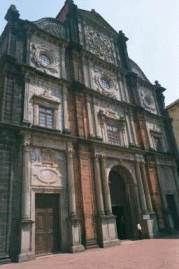
The Basilica of Bom Jesus
The ruins of St. Augustine's Church
From this church built in 1602 there remains only the high tower of 46 meters. At the end of its construction, the Church of St. Augustine was probably the largest in Goa, but after the departure of the religious in 1835 it fell into disrepair. In 1871, the bell in the tower was installed in the Church of Our Lady of the Immaculate Conception in Panaji. The facade collapsed in 1931 and the rest in 1938.
Santa Monica Church and Convent
The construction of the convent began in 1506 under the auspices of Archbishop Dom Frei Alexio de Menezes and ended in 1627. In 1636, the king of Portugal agreed to be its patron. That is why we talked about the Royal Monastery of Santa Monica. It could accommodate a few hundred nuns and served as a place of welcome for wives during the absence of their husbands. The convent was closed in 1885 and now houses the theological center of the Matar Dei Institute. The classic-style church houses the "miraculous cross". According to legend, on February 8, 1636, blood flowed from the wounds of Christ crucified and his eyes opened. The miracle was attested on the 24th of August of the same year.
Ponda
The city of Ponda is nothing special in itself but it is considered the Hindu heart of Goa due to the presence of many temples in its area. It was indeed here that most Hindus fled Portuguese persecutions. Most of the temples were built to house representations of deities that the faithful protected from destruction.
The temple of Sri Mangesh
This very elegant 18th century temple is one of the most important in Goa. It combines Hindu and Portuguese styles. It is dedicated to Mangheshi, one of the incarnations of Shiva. Inside are two sanctuaries dedicated to Parvati and Ganesh. The basin is the oldest part of the temple. Outside of a very beautiful six-story tower, a deepstambha, typical of the architecture of Goan.
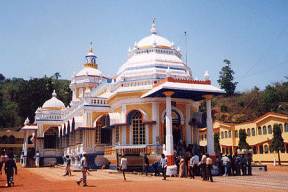
The temple of Sri Mangesh
The temple of Mahalsa Narayani
This temple was built in the early 16th century in honor of Mahalsa Narayani, a female incarnation of Vishnu. The temple is known for a very beautiful representation of Garuda, the winged mount of Vishnu. Outside is a deepstambha with six levels.
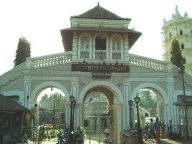
The temple of Mahalsa Narayani
The temple of Shantadurga
Built in 1738 this very pretty temple is dedicated to Shantadurga, incarnation of Parvati and goddess of peace. The main sanctuary contains a representation of Shantadurga surrounded by Shiva and Vishnu. Like many others, the temple is flanked by a deepstambha and a ratha (carved carriage).
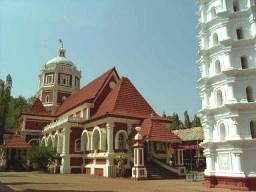
The temple of Shantadurga
The temple of Nagesh
As indicated by an inscription inside, this temple was erected in 1413 for Nagesh, god of serpents and incarnation of Shiva. The main hall is decorated with wooden panels with scenes from the Ramayana and the Mahabharata. In the holy of saints stands a lingam while at the entrance of the temple a Nandi welcomes the faithful.
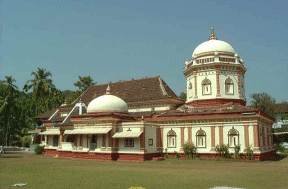
The temple of Naguesh
The temple of Sri Mahalakhmi
Located not far from the temple of Nagesh, it is dedicated to Mahalakshmi, wife of Vishnu. The particularity of the representation of this divinity is that it bears here a lingam, symbol of Shiva, on the head. The main hall of the temple houses a unique collection of 18 Vishnu wooden representations.
The Safa Shahouri mosque
It is the oldest and largest mosque in Goa. It was built, like 25 others, by the Sultan of Bijapur Adil Shah in the 1560s. The basin in front of the mosque is of period.
The beaches
Goa is famous for its beaches that attract thousands of tourists since the 60s in search of change of scenery. They offer all kinds of day and night activities and each one finds its corner of paradise according to its desires and its budget. The most beautiful and most popular are northern Panaji (between Candolim and Chapora) and south of Vasco de Gama.
Candolim
This small fishing village has lost much of its charm due to the explosion of tourism. The beaches of Candolim and Sinquerim are very popular. It however offers good infrastructure and the area is pretty. Candolim is famous for the presence of Fort Aguada in the south of the city. This imposing defensive structure was built by the Portuguese in 1612 to protect the estuary of the Mandovi. Very well preserved it offers today a beautiful panorama.
Calangute
The village of Calangute was for a long time one of the great rendezvous points of the hippies. This era is over and has given way to mass tourism. Calangute is divided into quarters (the waddos). To see, the church St. Alex built in 1741. Like Candolim, the beach of Calangute suffers from its success and is very frequented. It offers lots of activities but it is not the nicest beach. The road that leads to it is lined with shops of artisans. It is better to go a little further north to the Baga beach, less crowded and more pleasant.
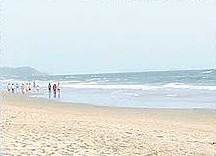
The beach of Calangute
See also:





